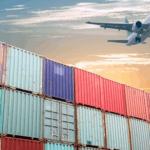- By TOP CHINA FREIGHT
- August 28, 2025
- Shipping
Rising costs and unpredictable delays are common challenges for businesses importing from China. Understanding shipping rates from China is essential to optimize your supply chain, reduce expenses, and maintain timely deliveries. This guide explores key factors influencing rates, tips to save money, and strategies for selecting the right transportation solutions.

1.Factors Affecting Shipping Rates from China
Air freight is faster but more expensive; sea freight is cheaper but slower.
Larger or heavier shipments typically have lower per-unit costs.
Longer routes and less direct paths increase freight costs.
Terminal handling, congestion fees, and customs charges can add to the total.
Peak periods like Q4 and pre-Chinese New Year often increase rates.
2.Average Shipping Rates from China by Mode
| Transport Mode | Typical Rates | Transit Time | Best For |
|---|---|---|---|
| Sea Freight (FCL) | $100–$300 per cubic meter | 10–30 days | Bulk shipments, low-cost cargo |
| Sea Freight (LCL) | $40–$80 per cubic meter | 10–30 days | Smaller shipments, flexible scheduling |
| Air Freight | $5–$10 per kg | 1–5 days | High-value or urgent cargo |
| Rail Freight | $150–$400 per container | 4–10 days | Medium-volume shipments to Europe/Asia |
| Express Courier | $10–$20 per kg | 3–7 days | Small parcels, urgent delivery |
3.How to Reduce Shipping Rates from China
1.Book in Advance:
Early bookings often secure better rates.
2.Consolidate Cargo:
Combine multiple small shipments to lower per-unit costs.
3.Optimize Container Load:
Maximize container space for FCL shipments.
4.Use Off-Peak Periods:
Avoid shipping during high-demand months.
5.Negotiate Long-Term Contracts:
Freight forwarders or carriers often provide discounts for repeated business.
4.Finding the Best Rates from China
When looking for competitive shipping rates from China, compare:
1.Carrier Pricing:
Check base rates, fuel surcharges, and additional fees.
2.Transit Times:
Faster options may cost more, but reduce inventory holding costs.
3.Reliability:
Consistent delivery schedules prevent penalties or customer dissatisfaction.
4.Service Coverage:
Ensure your destination is served directly or with minimal transshipment.
5.Understanding Hidden Costs
Costs for loading/unloading containers.
Based on cargo classification and value.
Bills of lading, certificates of origin, and permits.
Optional but recommended for valuable shipments.
6.Popular Routes and Typical Rates
| Route | Mode | Estimated Rate | Transit Time |
|---|---|---|---|
| Shanghai → Los Angeles | FCL Sea | $2,500–$3,500 per 40ft container | 14–20 days |
| Shenzhen → Rotterdam | Rail | $350–$450 per container | 12–18 days |
| Ningbo → Sydney | Air | $6–$8 per kg | 3–5 days |
| Guangzhou → Bangkok | LCL Sea | $50–$80 per cubic meter | 5–10 days |
7.Tools to Monitor Shipping Rates from China
Modern freight forwarders and carriers provide digital tools to track shipping rates from China:
1.Rate Calculators:
Estimate costs based on weight, volume, and destination.
2.Booking Platforms:
Lock in prices and schedule shipments online.
3.Market Updates:
Stay informed about seasonal rate fluctuations and fuel surcharges.
8.Real-Life Case Study
Reducing Shipping Costs
A medium-sized electronics supplier in Guangzhou regularly shipped 15–20 20ft containers per month to Europe. They faced high LCL costs and frequent peak-season surcharges. By consolidating shipments, using rail for long-distance transport, and negotiating long-term contracts with a forwarder, they:
- Reduced shipping costs by 18% per container.
- Improved transit time predictability.
- Avoided last-minute space shortages.
This demonstrates how strategic planning and partner selection can dramatically affect shipping rates from China.
9.Best Practices for Businesses

1.Compare multiple quotes:
Don’t settle for the first rate you receive.
2.Plan shipments strategically:
Combine air, sea, and rail if needed.
3.Use a trusted freight forwarder:
They can access better rates and negotiate with carriers.
4.Regularly review shipping performance:
Identify areas to reduce costs or improve delivery reliability.
10.Tips for Small and Medium-Sized Enterprises
SMEs can optimize shipping rates from China even with smaller volumes:
- Use LCL consolidation services to share container space.
- Schedule shipments during low-season periods to access better rates.
- Partner with forwarders that specialize in small-to-medium shipments.
- Negotiate flexible payment terms or volume-based discounts.
11.Global Impact on Rates
| Factor | Description |
|---|---|
| Geopolitical Tensions | Trade wars or sanctions can lead to sudden surcharges or route adjustments. |
| Natural Disasters | Typhoons, floods, or earthquakes in Asia can delay shipments and raise costs. |
| Pandemic Recovery Trends | Post-pandemic demand surges still influence freight capacity and pricing. |
| Global Economic Cycles | Inflation or recession directly affects fuel prices and overall freight demand. |
Conclusion
Understanding shipping rates from China goes beyond knowing base prices. Businesses can save significantly by strategically choosing transport modes, routes, cargo types, and shipping schedules. Partnering with experienced freight forwarders, leveraging technology, and planning shipments carefully ensures reduced costs, reliable delivery, and smoother supply chain operations.
Need a Shipping Quote?
If you want expert guidance and peace of mind, our team is ready to assist.
TJ China Freight offers tailored solutions to help businesses of all sizes ship more reliably from China.
FAQs
Q1:How often do shipping rates from China change?
Shipping rates fluctuate frequently due to fuel costs, seasonal demand, and port congestion. Carriers may adjust rates monthly or even weekly, so monitoring the market is crucial to secure competitive pricing.
Q2:Can I lock in shipping rates from China in advance?
Yes, many carriers and freight forwarders offer rate contracts or fixed-price agreements. This helps protect against seasonal surcharges and unexpected market fluctuations.
Q3:Do shipping rates from China include customs duties and taxes?
No, standard shipping rates usually cover only freight and basic handling. Customs duties, import taxes, and local port charges are additional and should be calculated separately.
Q4:Are there discounts available for repeated shipments?
Yes, carriers and forwarders often provide volume-based discounts or loyalty programs. Businesses that ship regularly can negotiate better rates and priority booking.
Q5:How do packaging and cargo dimensions affect shipping rates?
Rates depend on both weight and volume. Inefficient packaging or irregularly shaped cargo may increase costs due to wasted container space or special handling requirements.




